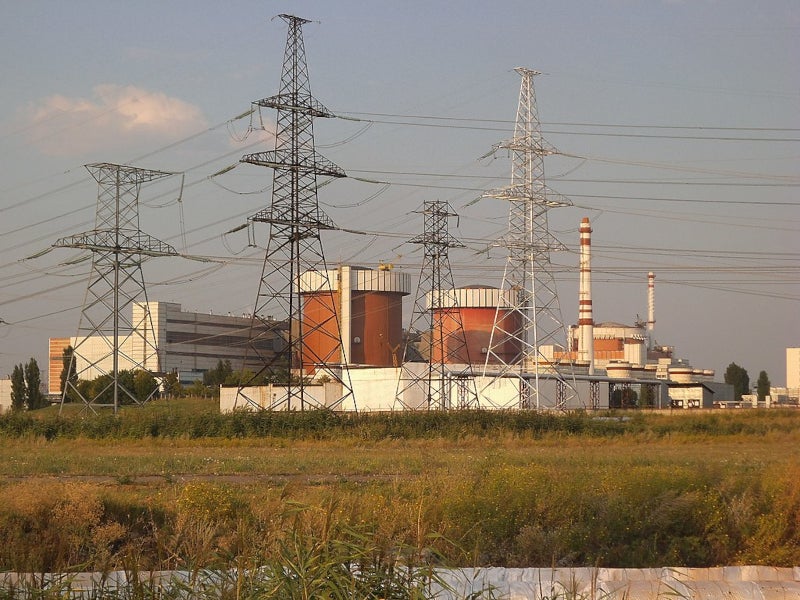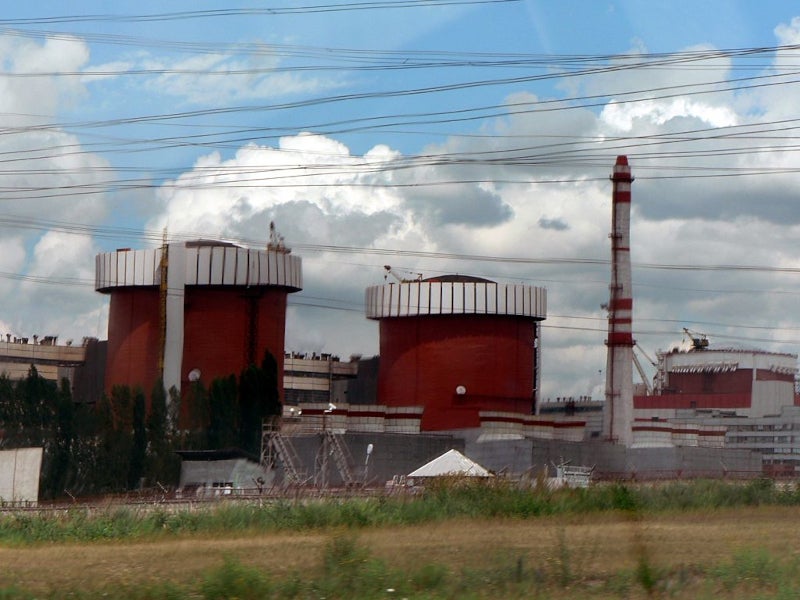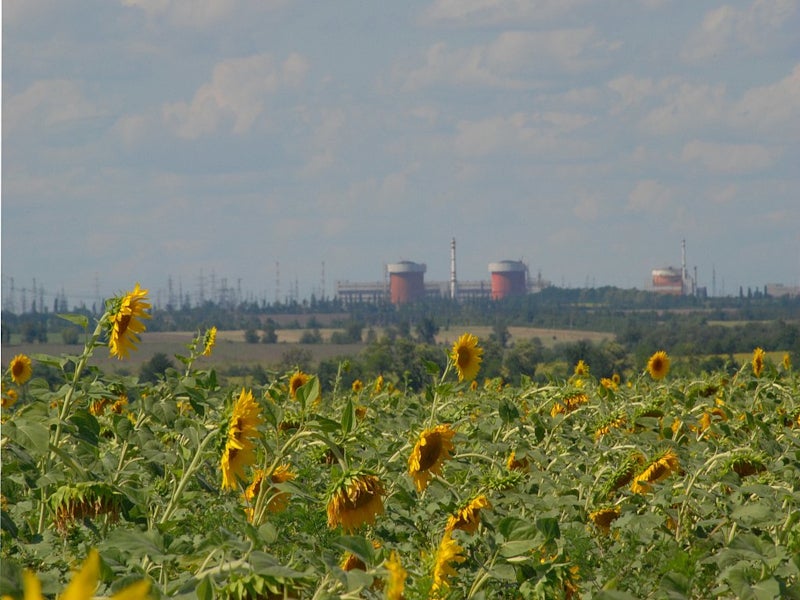Understand the impact of the Ukraine conflict from a cross-sector perspective with the Global Data Executive Briefing: Ukraine Conflict
The South Ukraine nuclear power plant (SUNPP) is located near Yuzhnoukrainsk in the Mykolayiv region of Ukraine and has a gross electrical capacity of 3GW. The facility is owned and operated by Energoatom, the state-owned nuclear energy generating company of Ukraine.
SUNPP has three 1,000MW pressurised light water reactors (PWR), which were supplied by Russia. The first unit was commissioned in December 1982, followed by the second and third units in April 1985 and December 1989, respectively.
The three power units fed more than 18,156 gigawatt-hours (GWh) of electricity into the Ukrainian power grid in 2020, accounting for about one-fourth of the total electricity supplied by all Ukrainian NPPs. SUNPP generates more than 10% of Ukraine’s electricity.
In 2013, 2015 and 2020, the State Nuclear Regulatory Inspectorate of Ukraine (SNRIU) granted ten-year lifetime extensions for the three SUNPP units until December 2023, December 2025 and February 2030, respectively.
Location and site details
SUNPP is part of the South Ukraine nuclear and hydropower complex located on the left bank of the Yuzhny Bug River near Yuzhnoukrainsk, 120km north of Mykolayi, in southern Ukraine.
The power complex also includes the Tashlyk pumped storage plant (PSP), operational since 2006, and 11.5MW Olexandrivka hydropower plant, which was commissioned in 1999.
The SUNPP is located 3km away from the river shoreline and uses the Tashlyk reservoir as its cooling pond. The motor road from Ulianovka to Mykolayiv runs along the Tashlyk water reservoir, 1km away from the SUNPP site fencing.
Construction of the South Ukraine NPP
The SUNPP was planned with four power units and a total capacity of 4GW.
Construction of the SUNPP Unit 1 began in August 1976, followed by Units 2 and 3 in July 1981 and November 1984, respectively.
Work on the fourth unit started in 1983, immediately after the commissioning of SUNPP-1. It was cancelled following the Chernobyl nuclear disaster due to a Resolution by the Council of Ministers of the former Union of Soviet Socialist Republics (USSR) in August 1989. The main building structure that had already been erected for the fourth unit was repurposed into a full-scale simulator to serve as the plant training centre.
South Ukraine nuclear power plant make-up
SUNPP-1 is equipped with a VVER-1000 (V-302) water-cooled water-moderated reactor and K-1000-60/1500 steam turbine paired with TVV-1000-4UZ generator.
SUNPP-2 comprises a VVER-1000 (V-328) reactor, along with a K-1000-60/1500 steam turbine and TVV-1000-4UZ generator.
SUNPP-3 uses a VVER-1000 (V-320) reactor and K-1000-60/3000 steam turbine connected to a TVV-1000-2UZ generator.
The reactor coolant system (RCS) of each reactor at the SUNPP comprises four circulation loops, with each loop consisting of RCS piping, GTsN-195M main coolant pump and PGV-1000M steam generator.
Service water for the SUNPP is sourced from the Tashlyk reservoir on the Yuzhny Bug River.
A total of 11 diesel generators (DGs) are used at the power station to provide emergency power supply. Each unit uses three DGs, while two additional DGs for common use are located at Unit 3.
Spray ponds at South Ukraine NPP
Energoatom is building five spray ponds at SUNPP with an estimated investment of UAH3.4bn ($120m) to improve the cooling performance of the plant.
Two of the five planned spray pools were commissioned in June 2021. Two more pools are expected to be commissioned in 2022 but could be delayed due to the Russian invasion of Ukraine.
Upon commissioning, the five spray ponds are expected to reduce the temperature of the plant’s circulating water by 7°C-8°C and improve its electricity production capacity during the hot season.
Fuel supply
The fuel division of Russia’s State Atomic Energy Corporation (Rosatom), TVEL, had been the sole supplier of nuclear fuel for all Ukranian NPPs. In 2005, Unit 3 of the SUNPP became the first nuclear power reactor in the country to use test fuel assemblies supplied by US-based company Westinghouse.
Unit 3 also became the first Ukrainian power reactor to operate exclusively with Westinghouse fuel in July 2018.
As of December 2021, six of Ukraine’s 15 active power reactors were operating with Westinghouse fuel, including Units 2 and 3 of the SUNPP and four units at Zaporizhzhya NPP.
Although a long-term fuel supply contract was signed with Russia’s TVEL for the entire nuclear reactor fleet of Ukraine in June 2010, Russia’s annexation of Crimea led Energoatom to extend its fuel contracts with Westinghouse through 2020, in April 2014.
Energoatom further extended the contract with Westinghouse in January 2018, including switching seven of its power reactors to operate entirely with Westinghouse fuel by 2025.
Spent fuel storage
The three reactors of the SUNPP produce up to 126 spent fuel assemblies a year, which are stored in racks for four to five years in the spent fuel pools (SFP) within the reactor containments.
After cooling, the spent fuel is loaded into special containers and transported for dry storage offsite.
The used nuclear fuel assemblies from the SUNPP will be stored at Ukraine’s central spent fuel storage facility (CSFSF) in Chernobyl. Construction of the dry interim storage CSFSF was completed in 2021. It was in the cold testing stage as of January 2022, with the first shipments of spent fuel expected in the second half of the year.
Designed with a storage capacity of 16,530 used nuclear fuel assemblies, the CSFSF will store the spent fuel from all nine reactors at the South Ukraine, Rivne and Khmelnytskyi NPPs.
Contractors involved
Atomstroyexport, a wholly-owned subsidiary of Rosatom, supplied the three VVER-1000 reactors used at the SUNPP.
Westinghouse currently supplies fuel for SUNPP-2 and SUNPP-3 and in March 2016, signed an agreement with Energoatom to upgrade the capacity of the turbine generator sets of VVER-1000 power units by up to 10%.
In a joint venture with Ukrainian company Hartron, Westinghouse also designed and installed the advanced digital computer information system (CIS) with detailed and high-resolution displays of safety and operating conditions for the SUNPP in the late 1990s.
PJSC Yuzhenergobud of Ukraine was the general contractor for the two spray pools commissioned at SUNPP in June 2021, while Italian company Termomeccanica Pompe manufactured and supplied pumping equipment for the project.






